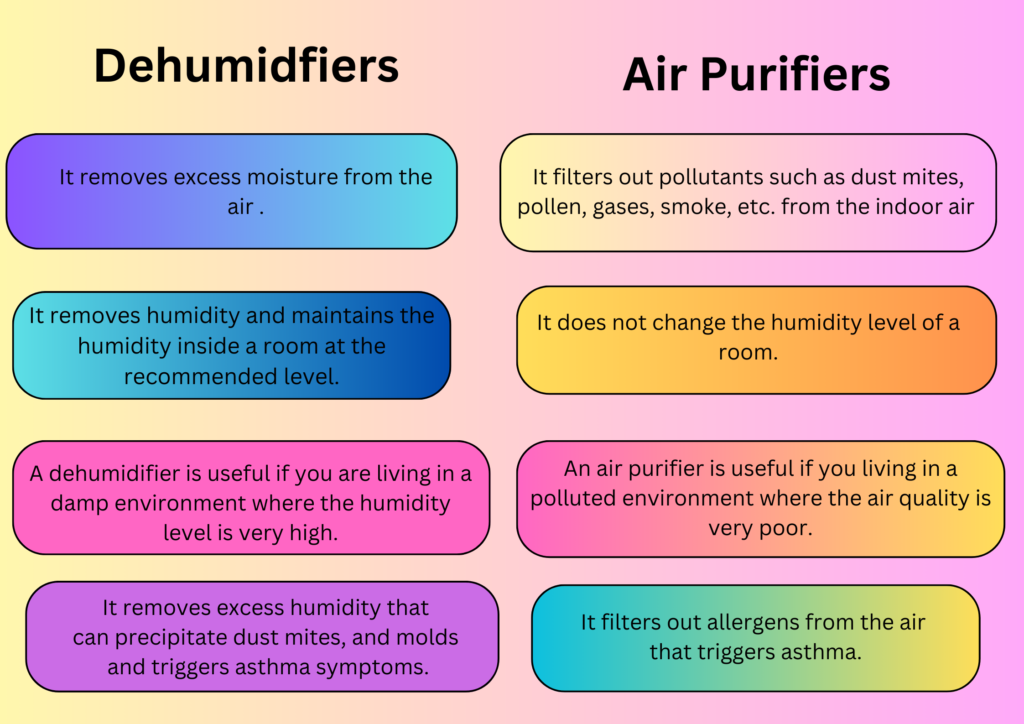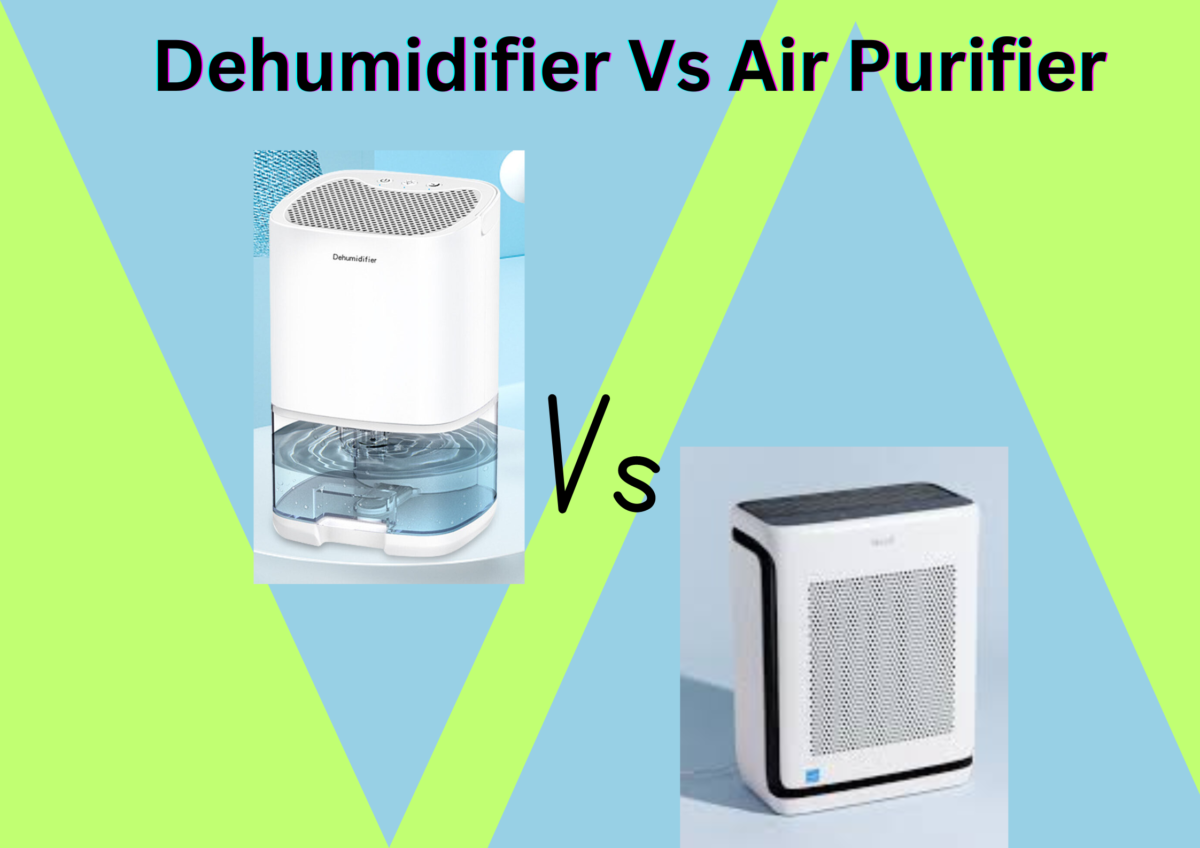According to the U.S. Environmental Protection Agency Americans spend almost 90% of their time indoors. So, it is important to maintain the indoor air quality. Short and long-term exposure to indoor air pollution causes various health issues such as allergic and asthma problems, respiratory diseases, etc. Again, the high humidity level in the air reduces air circulation and traps the pollutants, viruses, bacteria, and other microorganisms in the air.
So, to protect our health from several diseases, to prevent valuable household belongings from getting damaged, and most importantly to save energy homes should be equipped with air purifiers, dehumidifiers, humidifiers, etc.
So, which one should you use, a dehumidifier or an air purifier? The article “Dehumidifier Vs Air Purifier”, explains in detail the major differences between a dehumidifier and an air purifier, their types, working principles, uses, etc.

Definition:
Dehumidifier:
A dehumidifier is an electrical device that removes excess moisture from the air. It maintains the relative humidity of a room or, your home at the recommended level. It prevents mold growth, dust mites, unpleasant odors, and condensation inside the room.
The use of a dehumidifier offers a comfortable space free from moisture and harmful pollutants so that you can breathe easily. It helps in avoiding serious respiratory diseases and helps you lead a healthy life.
Air Purifier
An air purifier is a portable device that purifies the air in a specific room. It contains a fan that draws in indoor air and passes it through a filter. The filter pulls unwanted particles from the air and then circulates the purified air back into the room. This process continues for several times in an hour and improves the indoor air quality.
If you are staying in cities or, in industrial areas then an air purifier is a necessary device for your home. It provides you with clean, fresh, and healthy air to breathe. You can use this device throughout the year to get clean air irrespective of the climate and weather.
Basic Working Principle:
Working Principle of Dehumidifier
There are 4 main components of a dehumidifier.
- Electric fan: It draws in the humid air inside the device.
- Refrigerated or cooled coil: It extracts the moisture from the humid air.
- Hot condenser coil: It slightly reheats the air to get it back to its original temperature.
- Collection tray: It collects moisture that drips down from the refrigerated coil.
The step-by-step operating process of a dehumidifier is listed below.
- The electric fan of the dehumidifier draws the humid air inside the device.
- The air passes over the refrigerated or cooled coils. As the air gets cool the moisture in the air converts into liquid water.
- The liquid water drips down from the cooled coils and is collected into a tray.
- The air free of moisture then passes over the hot condenser coil and warms back up to its original temperature.
- Now the dehumidifier supplies the warm and dry air back into the room.
Working Principle of Air Purifier
An air purifier contains a fan, sensor, and a single or, multiple filters to purify the air.
- Fan: The fan inside the air purifier draws the surrounding air and passes it through various filters.
- Sensors: Before sending the air through the filter the sensor first detects the pollutants in the air.
- Filters: The air is then passed through various filters to remove harmful particles and impurities from the air.
The HEPA (High-Frequency Particulate Air) filter traps airborne particles like dust, pet dander, and pollen from the air. This type of filter can capture particles as small as 0.3 microns with an efficiency of 99.97%.
The activated carbon filters remove unpleasant odors from cooking, smoking, and pets, chemical fumes, and gases from the air.
The UVGI (Ultra Violet Germicidal Irradiation) cleaners eliminate bacteria, viruses, and other microorganisms from the air. This type of filter emits UV-C light which damages the DNA of these microorganisms and deactivates them.
- The purified air free from pollutants, chemical gases, and harmful microorganisms is circulated back into the room.

Types:
Types of Dehumidifiers:
There are mainly 3 types of dehumidifiers available in the market.
- Refrigerant dehumidifier:
In a refrigerant dehumidifier, a fan draws the humid air inside the device. When the air passes over the cold coils inside it the condensation process starts and the moisture in the air converts into liquid water. The water drips down from the coils and gets collected in a tray. The air free of moisture is then reheated and the warm and dry air gets circulated back into the room.
2. Desiccant dehumidifier:
In a desiccant dehumidifier, a fan draws the indoor air inside the device. The water passes through a constantly rotating wheel made up of desiccant material which adsorbs the moisture from the air. The wheel again passes through a stream of warm air which drives off the moisture and reactivates the wheel. The dry air then circulates back into the room.
3. Whole house dehumidifier:
The whole house dehumidifier is usually integrated with the HVAC system. The dehumidified air is supplied to the HVAC system and the HVAC system circulates the cool air free from moisture into the room.
Types of Air Purifier:
There are mainly 3 types of air purifiers available in the market.
- HEPA air purifier: High-efficiency particulate air (HEPA) air purifiers are the most common type. It can remove 99.97% of particles that are 0.3 microns in diameter or larger from the air.
- Carbon filter air purifier: These types of air purifiers remove VOCs, chemical gases, unpleasant odors, smoke, etc. from the air.
- UVC air purifier: These air purifiers use ultraviolet (UV) radiation to kill bacteria and viruses from the air.
Dehumidifier Vs Air Purifier
| Dehumidifier | Air Purifier | |
| Purpose | It removes excess moisture from the air and recirculates dry air back into the environment. | It filters out pollutants such as dust mites, pollen, gases, smoke, etc. from the indoor air and recirculates pollutant-free air back to the home. |
| Humidity Level | It removes humidity and maintains the humidity inside a room at the recommended level. | It does not change the humidity level of a room. |
| Useful for | A dehumidifier is useful if you are living in a damp environment where the humidity level is very high. | An air purifier is useful if you living in a polluted environment where the air quality is very poor. |
| Asthma Symptoms | It removes excess humidity that can precipitate dust mites, and molds and triggers asthma symptoms. | It filters out allergens from the air that triggers asthma. |
When to Use?
When to Use a Dehumidifier?
- It’s beneficial to use a dehumidifier during spring, summer, and early fall.
- If you measure the humidity level inside a room by using a hygrometer, and you find the relative humidity of the room is greater than 50%, then you need a dehumidifier to keep the humidity at the optimal level.
- If condensation appears on the glass of your windows, then it is a clear sign of a high level of humidity inside the room. In this situation, you need a dehumidifier to lower the humidity level of the room.
- If mold growth causes damage to your valuable belongings, it shows excess moisture inside your device. In this case, you need a dehumidifier urgently.
- If you feel any unpleasant odors inside your home or dampness in the basement area you need a dehumidifier to remove those odors.
- If anyone from your family is suffering from allergic symptoms, asthma, or, difficulty in breathing, you should consult your doctor and buy a dehumidifier. It may be due to the excess moisture which causes heaviness in the air.
When to Use an Air Purifier?
- If you feel any types of allergic symptoms like sneezing, itchy and watery eyes, runny nose, etc., for a long time it may be due to the airborne allergens present in the air. To remove these allergens, you need an air purifier.
- If you find your furniture, books, clothes, decorative items, etc. always covered in dust, it’s high time that you need an air purifier to remove those dust particles from the home.
- If you find stinky smells inside your home, you should use an air purifier to remove those odor-causing gases from the indoor air. It makes the indoor air clean and fresh.
Pros and Cons
Pros of Dehumidifiers
Reduce Allergy and Asthma Symptoms:
The excess moisture in the air causes difficulty in breathing for asthma patients. The highly humid contains dust mites which worsen allergic symptoms. A dehumidifier removes moisture from the air and makes breathing in and out easier for the lungs.
Creates a Healthier Environment:
By removing dust mites, allergens, and musty smells from the surrounding air, a dehumidifier helps in creating a healthier environment for you and your family. They will experience increased health and well-being.
Protects valuable belongings in the home:
A dehumidifier prevents mold growth which saves valuable belongings like photo frames, bikes, metal items, and wood from being warped and rusted. It also saves clothes, food items, and books from getting damaged which are highly susceptible to humidity.
Removes unpleasant odors:
The excess moisture inside the house creates a musty smell. The use of a dehumidifier removes moisture, eliminates these unpleasant odors, and makes your home smell fresh and welcoming.
Energy Efficient:
The use of a dehumidifier along with the HVAC system can also lower the energy costs. It helps reduce the load from the HVAC system to run efficiently. The HVAC system doesn’t have to work on removing moisture from the air and then cooling the air.
Cons of Dehumidifiers
- A dehumidifier sometimes makes the air more dry. It worsens some diseases like pneumonia.
- Dry air makes the mucus membranes dry and causes an itchy throat, dry cough, and stuffy nose.
- Dry air also makes your skin and scalp dry and itchy.
Pros of Air Purifier
Reduces Allergens:
An air purifier removes allergy triggers like dust, pet dander, pollen, etc. from the environment. Thus, it protects you from sneezing, itchy eyes, congestion, runny nose, etc.
Reduce Asthma Triggers:
An air purifier removes pollutants and airborne particles from the air that trigger asthma symptoms. It cleans and purifies the air so that you can breathe easily.
Protects from Airborne Diseases:
It eliminates airborne viruses and bacteria from the air. These viruses spread through the air and cause colds and flu to be transmitted from one person to another.
Removes Unpleasant Odors:
An air purifier removes unpleasant odors, chemical gases, etc. from your surrounding air and replaces them with clean and fresh air.
Improves Sleep:
An air purifier removes pollutants, allergens, dust mites, etc. from the air and protects you from diseases like asthma, coughs, colds, and sneezing. Thus it avoids many sleep disruptions and improves your sleep quality.
Cons of Air Purifier
- Some air purifiers generate ozone during operation which is known to exacerbate asthma.
Can I Use Both a Dehumidifier and an Air Purifier Simultaneously?
Yes, you can use both a dehumidifier and an air purifier simultaneously inside a home. They function differently, but together they can create a healthier indoor environment. A dehumidifier removes moisture from the air and prevents mold growth. An air purifier removes pollutants, allergens, dust, and pollen from the air. They also help to reduce allergic and asthma symptoms.
Using both a dehumidifier and an air purifier improves indoor air quality. If you live in polluted air where the air quality is inferior and you are also struggling with high humidity in the environment, you can use both devices together.
Conclusion
A dehumidifier removes excess moisture from the indoor air and maintains the humidity at the recommended level. It cannot clean the air thoroughly as the air purifier does. Neither the air purifier controls the humidity of the indoor air. An air purifier removes pollutants, dust, and other contaminants from the air.
Both devices have their unique importance in improving indoor air quality. If you live in polluted air where the air quality is inferior and you are also struggling with high humidity in the environment, you can use both devices together. So, choose the suitable device according to your requirements.
FAQS
- Can a dehumidifier purify air?
No, a dehumidifier cannot purify the air thoroughly as the air purifier does. It helps to maintain the humidity level of a room by removing excess humidity from the indoor air. It prevents mold and mildew growth. So, if you want to purify the indoor air an air purifier is a better option.
2. Is a dehumidifier or air purifier better for a stuffy room?
A dehumidifier is the better option for a stuffy room. It supplies air free from moisture inside the room and lowers the stuffiness inside the room. It makes the surrounding air/ better and healthier to live.
Also Read
- Dehumidifier vs. Air Conditioner 2024
- Cool Mist Humidifier: Types, Uses, Benefits, Working Principle 2024
- Do Humidifiers Help with Air Quality? 2024
- When Do You Need a Humidifier? 8 Common Signs
- How Do Humidifiers Work? A Complete Guide 2024
- How Humidifier Helps Breathing? 2024
- Humidifier Vs Dehumidifier Vs Air Purifier: Which One Should You Buy? 2024


13 thoughts on “Dehumidifier Vs Air Purifier: A Complete Comparison”